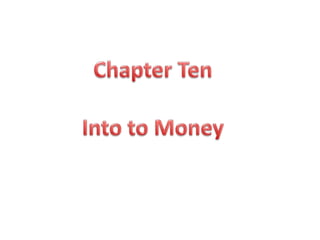
Into to money
- 1. Chapter Ten Into to Money
- 2. Before there was money, there was barter.
- 3. p. 243 Barter – the direct exchange of one set of goods or services for another -- used before there was money
- 5. Children swap cards What was your favorite Pokémon card?
- 6. Parents make deals – watch your little sister tonight and you can stay out later tomorrow night Saudi and British Aerospace swap fighter planes for oil
- 7. In order to evade taxes, businesses will barter. A dentist needs her car fixed and a car mechanic needs a root canal. Illegal if not reported for income tax purposes.
- 8. p. 243 Money anything that serves as a medium of exchange, a unit of account, and a store of value. Early money
- 9. WAMPUM Beaded shells, called wampum, were the most common form of money in North America.
- 10. By 1637, the Massachusetts Bay Colony declared wampum legal tender (ok to use as money).
- 11. CONTINENTALS These were America's original ‘bucks‘ (deer hide once used as money).
- 12. To finance the American Revolution, Congress authorized the first printing of currency by the new republic. But without the strong financial backing of gold or silver, the Continentals quickly devalued and were soon worthless - thus the expression, "not worth a continental."
- 13. WILDCATS In the so-called Free Banking Era, America was flooded with various currency notes - many of which were redeemable in gold or silver, but some were worthless. Some banks would set up shop in remote mountainous regions, prompting people to comment that it was easier for a wildcat to redeem these notes than people - thus the name.
- 14. BROKEN NOTES “Broken" notes refers to the frequency in which the banks that issued them went bust. Without the confidence that these notes could be redeemed, they were virtually worthless.
- 15. GREENBACKS
- 16. Pressed to finance the Civil War, the U.S. government resumed printing paper currency for the first time since it issued Continentals. The name itself, a reference to its color, has become as much a part of Americana as apple pie.
- 17. In addition to its new color, "greenbacks" incorporated a more complex design, including a Treasury Seal, fine-line engraving and various security measures.
- 18. p. 247 Representative Money (Fiduciary) – objects that have value because the holder can exchange them for something else of value IOU’s, checks and bank notes -- because both are some kind of token which are used as money and carries the same value
- 19. How paper cheques came to be: Gold too heavy to carry. Goldsmiths issued receipts. People traded the receipts. Could redeem in gold. Idea stuck.
- 20. Take this one step further – why even have money backed by anything? *Fiat Money – money that has value because the government has ordered that it is an acceptable means to pay debts
- 21. 1933, FDR signed the executive order that changed the dollar from being representative money to inconvertible fiat.
- 22. It is not enough that the government says this is legal tender -- Confederacy said that their money was legal tender, but no one would take it -- not even die-hard Southerners
- 23. Money has to be limited to have value That was what the gold standard did – amount of money limited by the amount of gold
- 24. Gold Standard Ft. Knox gold vault
- 25. Gold Standard 1873 - 1933 Checks inflation, but economy cannot grow past amount of gold. Adam Smith said it is not how much gold, but the sum of all the goods and services an economy produces
- 26. FEDERAL RESERVE NOTES Open up your wallet - if you're carrying some cash on you, chances are its a Federal Reserve Note. Following the Federal Reserve Act of 1913, these notes became the dominant form of paper currency in America
- 27. Over the years, these notes have changed very little – they have been reduced in size in 1929 and the words "In God We Trust" were added in 1955.
- 29. Money is backed by faith and anything that erodes that faith is destructive to money. Counterfeiting and overprinting. German Weimar Republic example
- 30. Keep Up with what’s Happening http://money.cnn.com/ http://www.smartmoney.com/ http://www.frbatlanta.org/pubs/dollarscents/dollars_and_cents-currency_features.cfm?redirected=true
- 31. End